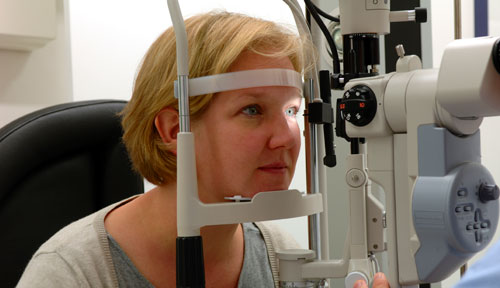From basic eye exams to complex treatments for specialized diseases, the expert clinicians at the Stanley M. Truhlsen Eye Institute will provide clinical care to patients in a state-of-the-art facility.
The clinic, set to open on Monday, June 3, will house 50 exam rooms in 10 areas dedicated to eight subspecialties.
First floor:
- cornea and cataract
- comprehensive ophthalmology
- optometry and contact lenses
- oculofacial plastics
Second floor:
- children’s eye care center
- glaucoma
- neuro-ophthalmology and uveitis
- retinal diseases
- uveitis (ocular inflammation)
Patients who come to the Truhlsen Eye Institute will receive care that combines the clinical expertise of specialized physicians along with innovative therapeutic options and better diagnostic equipment that only an academic medical center can provide.
“There is no need to go outside of Nebraska anymore,” said Quan Dong Nguyen, M.D., the chair of the Ophthalmology and Visual Sciences Department. “We have it all here at the Truhlsen Eye Institute.”
Eye care experts in the Carl Camras Center for Innovative Clinical Trials offer patients cutting-edge, new therapeutic options for eye care – options not available elsewhere in the region. The center will provide the latest treatments for retinal diseases and anterior segment disorders.
Also, basic eye exams become even more convenient with a new expanded optical shop offering attractive frames, sunglasses and accessories to compliment all faces and personalities.
The goal to improve eye care for patients in all areas of the region is becoming a reality with plans underway to hold subspecialty clinics in rural areas such as Grand Island, with telemedicine sessions for monitoring and follow up care. The Truhlsen Eye Institute is expected to attract patients from all areas of the state. Certain subspecialty care like Dr. Nguyen’s expertise in uveitis and ocular inflammation is an example of something that has not been available up to this point.
“Previously patients have had to travel a long distance to get this type of care,” Dr. Nguyen said. “We are very excited to begin seeing patients in our new facility and look forward to the advancements and technology that we will be able to offer to further the treatments and outcomes of eye patients everywhere.”
This summer, the clinic will join the rest of the clinical enterprise on One Chart and in the fall, diagnostic equipment will be integrated with the new electronic health records, further improving the patient experience and improving coordination across the continuum of care.
